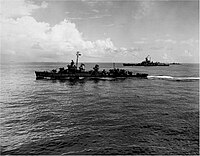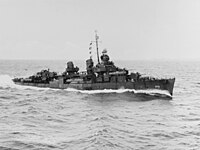Class 119
|
|
|
|---|---|
| Class 119 | |
| Destroyer 1 class | |
 Destroyer 6 at the Kiel Week 1962 |
|
| Overview | |
| Type | destroyer |
| units | 6th |
| Shipyard |
see units |
| Keel laying | 1941 to 1942 |
| Launch | 1942 to 1943 |
| Commissioning | 1958 to 1960 |
| Decommissioning | 1967 to 1982 |
| Technical specifications | |
| displacement |
2250-2750 ts |
| length |
114.70 m |
| width |
12.00 m |
| Draft |
4.40 m (standard) |
| drive |
|
| speed |
36 kn |
| Armament |
|
The class 119 of the German Navy was from the late 1950s - under the US Military Assistance Program adopted six - destroyers of the Fletcher class formed.
history
Fletcher class
Between 1941 and 1945, 175 Fletcher-class destroyers were built for the United States Navy . 19 of them were lost in the war. 145 destroyers were decommissioned after the end of the war and assigned to the reserve fleet .
As early as 1948, 18 units began to be reactivated and converted for submarine hunting . Another 60 destroyers were reactivated and modernized in two different configurations. Of the 18 anti-submarine units, three destroyers were later modernized again as part of the FRAM II program.
In the 1950s, many Fletcher destroyers were handed over to various navies, both in their original configuration and in a modernized form.
The US Navy began to permanently decommission the Fletcher-class destroyers from 1969. Some destroyers of this class remained in service well beyond the 1990s. The last ship of the class, the BAM Cuitlahuac (ex USS John Rodgers (DD-574)), was decommissioned from the Mexican Navy on June 16, 2001. This ended the era of the Fletcher destroyers after almost 60 years.
Federal Navy
Since the time for planning, building and testing its own larger ships was not available, the Federal Republic of Germany received six Fletcher-class destroyers for the German Navy from the USA from 1958 to 1960 as part of the American Military Assistance Program . An option for the surrender of five more destroyers was not taken. After the loan period was extended in the meantime, the four units that were still in existence at that time were purchased in 1976 for the equivalent of around € 191,500 each.
The class 119 destroyers were not given any names when they were commissioned, they were only numbered from 1 to 6. It was not until 1960 that they were given the names Destroyer 1 to Destroyer 6 . In common parlance, the destroyers Z 1 , Z 2 , Z 3 , Z 4 , Z 5 and Z 6 were named.
After their commissioning, the first three destroyers were assigned to the 1st destroyer squadron, and the other three to the 3rd destroyer squadron. The home port for all units was Kiel . The destroyer 3 was placed under the fleet service squadron in Flensburg from April 1, 1974 . From October 1, 1971, the remaining destroyers were combined in the 3rd destroyer squadron. After the dissolution of the 3rd Destroyer Squadron on June 30, 1981, the two remaining destroyers, Destroyer 2 and Destroyer 5, were placed under the 1st Destroyer Squadron until they were decommissioned.
After their decommissioning, destroyers 1 and 6 were cannibalized as spare parts reserves for the other destroyers. Destroyer 6 was canceled and Destroyer 1 was then used up as a target ship for naval aviation in the Mediterranean. On May 16, 1979, the destroyer Destroyer 1 was sunk by the German submarine U 29 by torpedo fire.
The other destroyers were handed over to the Greek Navy as part of defense aid.
The tasks of the destroyers of the destroyer 1 class were taken over by the frigates of the Bremen class .
technology
Before the takeover, the ships were modernized to a considerable extent. All 20 mm Oerlikon cannons were removed and the 40 mm Bofors guns were replaced by three 76.2 mm twin flak. In order to gain the deck space required for these guns and the fire control equipment connected to them, the third 127 mm turret and the front quintuplet torpedo tube set had to be removed. The electronics were modernized and the mast was replaced by a tripod mast.
When the six destroyers were in dock later, in accordance with German requirements, the initially open bridges were transformed into a closed bridge while at the same time being enlarged. Three destroyers (Destroyer 2, Destroyer 3 and Destroyer 4) were each provided with a small hut on the back of the bridge. Furthermore, all six units were retrofitted with two U-defense torpedo tubes (single UTR 533 mm). The second quintuplet torpedo tube set was later removed.
From the beginning of the 1960s to 1962, destroyer 4 had two 40 mm Bofors flak MELs in the positions of the 76.2 mm flak on the port and starboard sides. For testing purposes, a containerized 76-mm Oto Melara tower was carried in place of the eighth 76.2 mm anti-aircraft twin from 1974 to spring 1975 .
units
| F letcher - class | ||||||||
|---|---|---|---|---|---|---|---|---|
| Surname | Identifier | Shipyard | keel interpretation |
Stack run |
Indienst- position |
Außerdienst- position |
Deleted [a] | photo |
| USS Ringgold | DD 500 | Federal Shipbuilding and Drydock Company | 06/25/1942 | 11/11/1942 | 12/30/1942 | 03/23/1946 | October 01, 1974 |

|
| USS Anthony | DD 515 | Bath Iron Works | 08/17/1942 | December 20, 1942 | 02/26/1943 | 04/17/1946 | 04/15/1972 |

|
| USS Wadsworth | DD 516 | Bath Iron Works | 08/18/1942 | August 18, 1943 | May 16, 1943 | 04/18/1946 | October 01, 1974 |

|
| USS Charles Ausburne | DD 570 | Consolidated Steel Corporation | 05/14/1941 | March 16, 1942 | 11/24/1942 | 04/18/1946 | December 01, 1967 |

|
| USS Claxton | DD 571 | Consolidated Steel Corporation | 06/25/1941 | 04/01/1942 | December 8, 1942 | 04/18/1946 | October 01, 1974 |

|
| USS Dyson | DD 572 | Consolidated Steel Corporation | 06/25/1941 | 04/15/1942 | 12/30/1942 | March 31, 1947 | October 01, 1974 |

|
[a] Removed from US Navy list of ships.
| Z first ö rer 1 - class | |||||||
|---|---|---|---|---|---|---|---|
| Surname | Identifier | Radio call sign | Indienst- position |
Außerdienst- position |
Whereabouts | photo | |
| until 11/30/1981 | from 01.12.1981 | ||||||
|
Destroyer 1 ex USS Anthony (DD-515) |
D 170 (line 1) |
DBZQ | - | January 17, 1958 | 03/17/1972 | Sunk in 1979 as a target ship by U 29 off Crete | |
|
Destroyer 2 ex USS Ringgold (DD-500) |
D 171 | DBOV | - | 06/14/1959 | 09/18/1981 | to Greece Kimon (D 42), canceled in 1993 |

|
|
Destroyer 3 ex USS Wadsworth (DD-516) |
D 172 | DBOW | - | 10/06/1959 | October 15, 1980 | to Greece Nearchos (D 65), canceled in 1991 | |
|
Destroyer 4 ex USS Claxton (DD-571) |
D 178 | DBOX | - | December 15, 1959 | 02/26/1981 | to Greece, spare parts reserve, canceled in 1991 | |
|
Destroyer 5 ex USS Dyson (DD-572) |
D 179 | DBQY | DRAI | 02/17/1960 | 02/26/1982 | to Greece, spare parts reserve, canceled in 1993 | |
|
Destroyer 6 ex USS Charles Ausburne (DD ‑ 570) |
D180 | DBRB | - | 04/12/1960 | 10/09/1967 | 1968 to Harmsdorf in Lübeck , canceled |

|
See also
literature
- Gerhard Koop, Siegfried Breyer: The ships, vehicles and planes of the German Navy 1956 until today . Munich 1996, ISBN 3-7637-5950-6 .
- Wolfgang Harnack: The destroyer flotilla of the German Navy from 1958 until today . Hamburg 2001, ISBN 3-7822-0816-1
- Stefan Terzibaschitsch : Destroyer of the US Navy . Augsburg 1997, ISBN 3-86047-587-8
Web links
- Class 119 on marine.de
- (engl.) The History - Fletcher-Class Destroyer of the Federal German Navy - Destoerer 1
- Homepage of the Greek Navy on Destroyer ex Nearchos (D 65) / ex Destroyer 3 (D 172) ( Memento from April 14, 2009 in the Internet Archive )
Individual evidence
- ^ Military Assistance Program in the English language Wikipedia
- ↑ Terzibaschitsch: Destroyer of the US Navy
- ^ Koop, Breyer: The ships, vehicles and planes of the German Navy 1956 until today
- ↑ Harnack: The Destroyer Flotilla of the German Navy from 1958 to today
- ^ Consolidated Steel Corporation in the English language Wikipedia
